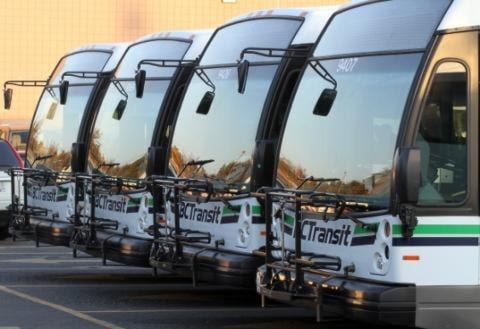Campbell River’s public transit system is about to receive a major overhaul.
As of Aug. 28, riders of BC Transit buses in Campbell River will, among other system and infrastructure upgrades, no longer have to transfer buses at the Community Centre or even have to transfer buses at all, in many cases, in order to get from one point in town to another.
The existing system is what BC Transit calls a “hub and spoke” system, where routes begin and end at the Community Centre and that’s where people need to transfer from one bus to the next in order to get where they are going. James Wadsworth, senior transit planner for BC Transit, says the new system will eliminate the need for a central transfer station, because people will be able to use transfers at any of the city’s bus stops.
James Wadsworth, senior transit planner for BC Transit, says the process involved in revamping the Campbell River transit system has been long, but he feels the changes being made will be welcomed by the community’s riders, partly because those riders have been involved in the decisions themselves.
“We did a lot of consultation,” Wadsworth says, including a public open house earlier this year and an online forum and survey.
“We also made sure we consulted with the bus drivers, because they know the customers they service better than anyone else and they had some ideas about how we could tweak the service, as well.”
The expansion also means an extra two buses coming to town and an additional 1,500 hours of transit time for the community.
That amounts to “about one full-time driver,” Wadsworth says, “but the key difference people will see will be in the changes in shifts so we can add more service during peak shifts when people are generally going to work and school.”
Wadsworth says BC Transit is hoping this system overhaul will also help to increase ridership by making it more attractive to people now that they won’t have to wait so long between buses or transfer from one to another at a hub to get where they need to go. In fact, both the Dogwood and Alder routes will have double the number of trips than are currently offered, which he says should make commuting by transit a much more attractive option for people.
City Transportation Manager Drew Hadfield says that’s the city’s hope, as well.
“As part of the transportation planning process that was done in 2011, a big part of it is to try and reduce the number of people in cars, by themselves, driving around,” Hadfield says. “So by providing frequent and reliable service – the two key goals that BC Transit is doing with this – we’re hoping to draw two, three, four per cent of the population that is in their car right now out of them and increase the transit road share. There’s a real benefit to the community in that. As a growing community we’re naturally seeing more and more cars on the road, and if we’re able to not necessarily reduce but at least maintain that number – we won’t have to add a bunch of infrastructure. And there’s obviously the greenhouse gas emmission benefit, as well.”
The new system will be structured around three main new north/south routes. One on Dogwood Street, one on Alder Street and one on the Island Highway. With the elimination of the downtown hub at the Community Centre, Wadsworth says, “all of those buses will go all the way from Willow Point to Campbellton and vice-versa, so most people aren’t going to have to transfer at all.”
One concern south of town was that people would need to cross the highway to get to the side the bus stop was going to be on, so they added a stop to the east side of the highway to avoid that complication.
Wadsworth wants the community to know that although the new transit system is going to take some getting used to, they will do everything they can to make the transition understandable for people. There will be cards on every bus that will outline the changes, new routes, stops and transfer system. There will also be extra BC Transit staff brought in to be on hand during the first few days of implementation to personally help riders through the changes.
He also says they will be reviewing the changes and their implementation about six months down the road and doing another consultation with the public to see if anything needs another tweak, but he thinks that once people get used to the changes, they will be happy with what they’ve come up with.
“I really think that people are going to come to appreciate the new system,” he says.
